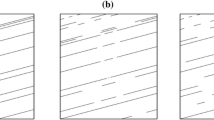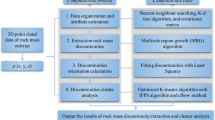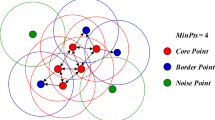Abstract
Recent advances in the use of remote sensing techniques allow the acquisition of dense 3D information helpful for the characterization of the rock mass joints. This implies the necessity of having robust and reliable methods to evaluate and extract the primitive geometries representing discontinuities on a rock outcrop. Moreover, these methods have to be easy to use, fast and accurate, which leads nowadays to the tendency of developing automated methods, often having limitations as concerns processing time, definition of parameters and, especially, accuracy. We present here an alternative approach based on two new semi-automatic algorithms, the Iterative Pole Density Estimation (IPDE) and the Supervised Set Extraction (SSE), used in combination with well-known and suitable clustering and density estimation methods. The IPDE performs an analysis based on a threshold value, within which it searches for coplanar points in a range of tolerance, automatically eliminating those below the established threshold, and then finding principal orientations by Kernel Density Estimation (KDE) and identifying clusters by a manual evaluation or through automated clustering methods. The SSE is a tool that allows to extract discontinuity sets from point clouds through an approach aimed to combine observations made in situ with digital results, taking into account the crucial importance of traditional analysis by an expert user. The method was tested in Campania (Italy) at the Cocceio Cave and at the Cetara Tower cliff: at the cave, we were able to recognize an additional set, not identified during previous digital analysis. In the second case, a fully automatic technique, with little or no human intervention on the point cloud, was compared with a previously made supervised method to perform the semi-automatic approach, eventually checking both results with those from traditional surveys, which led the whole analysis to shift the focus on the combined method proposed.


















Similar content being viewed by others
Data Availability
The data that support the findings of this study may be available upon request. Restrictions apply to the availability of these data, which were used under license for this study. Data may be available with the permission of Idrogeo S.R.L. (Vico Equense – Naples – ITA).
Code availability
Name of the code/library: GeoDS (Geological Data Science).
Contact: stefano.cardia@uniba.it.
Program language: Python 3.x
Code size: 30 KB.
The source codes are available for downloading at the link: https://github.com/StewTheBrew/geods
References
Abellán A, Oppikofer T, Jaboyedoff M, Rosser NJ, Lim M, Lato MJ (2014) Terrestrial laser scanning ofrock slope instabilities. Earth Surf Proc Land 39:80–97
Abellan A, Derron MH, Jaboyedoff M (2016) Use of 3D Point Clouds in Geohazards. Remote Sens 8:130. https://doi.org/10.3390/rs8020130
Andriani GF, Parise M (2015) On the applicability of geomechanical models for carbonate rock masses interested by karst processes. Environ Earth Sci 74:7813–7821. https://doi.org/10.1007/s12665-015-4596-z
Andriani GF, Parise M (2017) Applying rock mass classifications to carbonate rocks for engineering purposes with a new approach using the rock engineering system. J Rock Mech Geotech Eng 9:364–369
Arthur D, Vassilvitskii S (2007) K-means++: the advantages of careful seeding. Proceedings of the eighteenth annual ACM-SIAM symposium on Discrete algorithms. Society for Industrial and Applied Mathematics Philadelphia, PA, USA.1027–1035
Barnobi L, La Rosa F, Leotta A, Paratore M (2009) Analisi geomeccanica e di caduta massi tramite rilievo geostrutturale con geologi rocciatori e Laser Scanner 3D. GdiS 4(2009):33–40
Beloch J (1989) Campania – Storia e topografia della Napoli antica e dei suoi dintorni. Reprint by Ferone C. and Pugliese Carratelli F., Bibliopolis, Napoli, pp 461
Bieniawski ZT (1973) Engineering classification of jointed rock masses. T S Afr Inst Civ Eng 15:335–344
Bieniawski ZT (1989) Engineering Rock Mass Classifications: A Complete Manual for Engineers and Geologists in Mining, Civil, and Petroleum Engineering. John Wiley & Sons (New York City), Technology & Engineering, p 272
Borrmann D, Elseberg J, Lingemann K, Nüchter A (2011) The 3D hough transform for plane detection in point clouds: A review and a new accumulator design. 3DR express 2:2–14
Calcaterra D, Parise M, Palma B (2003) Combining historical and geological data for the assessment of the landslide hazard: a case study from Campania, Italy. Nat Hazard 3(1/2):3–16
Calcaterra D, Parise M (Eds.) (2010) Weathering as a predisposing factor to slope movements. Geological Society of London, Engineering Geology Special Publication no. 23, 233
Calcaterra D, Parise M, Palma B, Pelella L (1999) The May 5th, 1998, landsliding event in Campania (Southern Italy): inventory of slope movements in the Quindici area. Proc. International Symposium on Slope Stability Engineering, Shikoku, Japan, November 8–11, 1999, 2, 1361–1366
Calcaterra D, Parise M, Palma B, Pelella L (2000) Multiple debris flows in volcaniclastic materials mantling carbonate slopes. Proceedings 2nd International Conference on “Debris-Flow Hazards Mitigation: Mechanics, Prediction, and Assessment”, edited by Wieczorek G.F. and Naeser N.D., Taiwan, August 16–18, 2000, 99–107
Cardia S, Langella F, Pagano M, Palma B, Parise M (2022) 3D structural analysis of the cave of Saint Michael at Minervino Murge, Bari (Italy) – a typical case of karst environment in Puglia, EGU General Assembly, Vienna (Austria), 23–27 May 2022, EGU22-2329. https://doi.org/10.5194/egusphere-egu22-2329
De Riso R, Budetta P, Calcaterra D, Santo A, Del Prete S, De Luca C, Di Crescenzo G, Guarino PM, Mele R, Palma B, Sgambati D (2004) Fenomeni di instabilità dei Monti Lattari e dell’area flegrea (Campania): scenari di suscettibilità da frana in aree-campione. Quaderni Di Geologia Applicata 11:1–26
Dewez TJB, Girardeau-Montaut D, Allanic C, Rohmer J (2016) Facets: a CloudCompare plugin to extract geological planes from unstructured 3d point clouds. Int Arch Photogramm Remote Sens Spat Inf Sci. 41. https://doi.org/10.5194/isprs-archivesXLI-B5-799-2016
Di Girolamo P, Ghiara MR, Lirer L, Munno R, Rolandi G, Stanzione A (1984) Vulcanologia e petrologia dei Campi Flegrei. Boll Soc Geol Ital 103:349–413
Di Vito MA, Arienzo I, Braia G, Civetta L, D’antonio M, Di Renzo V, Orsi G (2011) The Averno 2fissure eruption: a recent small-size explosive event at the Campi Flegrei caldera (Italy). Bull Volcanol 73:295–320
Ferrero AM, Forlani G, Roncella R, Voyat HI (2009) Advanced Geostructural Survey Methods Applied to Rock Mass Characterization. Rock Mech Rock Eng 42:631–665. https://doi.org/10.1007/s00603008-0010-4
Figueiredo MAT, Jain AK (2002) Unsupervised Learning of Finite Mixture Models. IEEE Trans Pattern Anal Mach Intell 24:381–396. https://doi.org/10.1109/34.990138
Galgaro A, Genevois R, Teza G, Conforti D, Rocca M (2004) Monitoraggio da terra di fenomeni di instabilità geologica mediante sistemi di telerilevamento laser scanner: un primo test sulle Cinque Torri (Cortina d’Ampezzo, BL). Telerilevamento 2004:11–15
Girardeau-Montaut D (2016) https://www.cloudcompare.net/forum/
Hammah RE, Curran JH (1998) Fuzzy Cluster Algorithm for the Automatic Identification of Joint Sets. Int J Rock Mech Mining Sci 35(8):889–905 (PII: S0148 9062(98)00011-4)
Harris CR, Millman KJ, van der Walt SJ, Gommers R, Virtanen P, Cournapeau D, Oliphant TE (2020) Array programming with NumPy. Nature 585:357–362. https://doi.org/10.1038/s41586-020-2649-2
Hunter JD (2007) Matplotlib: A 2D Graphics Environment. Comput Sci Eng 9(3):90–95
ISRM (International Society for Rock Mechanics) (1978) Suggested Methods for the Quantitative Description of Discontinuities in Rock Masses. Int J Rock Mech Mining Sci Geomech Abstr 15:319–368
Jaboyedoff M, Oppikofer T, Abellán A, Derron MH, Loye A, Metzger R, Pedrazzini A (2012) Use of LiDAR in landslide investigations: a review. Nat Hazards 61:5–28
Jaboyedoff M, Metzger R, Oppikofer T, Couture R, Derron M-H, Locat J. Turmel D (2007) New insight techniques to analyze rock-slope relief using DEM and 3D-imaging cloud points: COLTOP-3D software. In Eberhardt, E., Stead, D and Morrison T. (Eds.): Rock mechanics: Meeting Society’s Challenges and Demands 1, Taylor & Francis. 61–68. https://doi.org/10.1201/NOE0415444019-c8.
Kemeny J, Turner K, Norton B (2006) LIDAR for Rock Mass Characterization: Hardware, Software, Accuracy and Best-practices, Laser and Photogrammetric Methods for Rock Face Characterization. ARMA Golden, Colorado
Kington J (2019) https://pypi.org/project/mplstereonet/. https://github.com/joferkington/mplstereonet
Li L, Sung M, Dubrovina A, Yi L, Guibas L (2019) Supervised Fitting of Geometric Primitives to 3D Point Clouds. IEEE EXplore. Computer Vision Foundation. CVPR 2019: 30-39
Lirer L, Petrosino P, Alberico I, Armiero V (2011) Carta Geologica di Cuma, Averno e Monte Nuovo (Scala 1:10.000)
Loiotine L, Andriani GF, Jaboyedoff M, Parise M, Derron M-H (2021a) Comparison of remote sensing techniques for geostructural analysis and cliff monitoring in coastal areas of high tourist attraction: the case study of Polignano a Mare (Southern Italy). Remote Sens 13:5045
Loiotine L, Wolff C, Wyser C, Andriani GF, Derron M-H, Jaboyedoff M, Parise M (2021b) QDC-2D: a semi-automatic tool for 2D analysis of discontinuities for rock mass characterization. Remote Sens 13:5086
Lombardi G, Rozza A, Casiraghi E, Campadelli P (2011) A Novel Approach for Geometric Clustering based on Tensor Voting Framework. Conference: WIRN 2011, pp. 210–217
Mahalanobis PC (1936) On the generalised distance in statistics. Proceedings of the National Institute of Sciences of India 2:49–55
Mammoliti E, Di Stefano F, Fronzi D, Mancini A, Malinverni ES, Tazioli A (2022) A Machine Learning Approach to Extract Rock Mass Discontinuity Orientation and Spacing, from Laser Scanner Point Clouds. Remote Sens 14:2365. https://doi.org/10.3390/rs14102365
McKinney W (2010) Data structures for statistical computing in python. In Proceedings of the 9th Python in Science Conference Vol. 445, pp. 51– 56
Menegoni N, Giordan D, Perotti C (2021) An Open-Source Algorithm for 3D Rock Slope Kinematic Analysis (ROKA). Appl Sci 11:1698. https://doi.org/10.3390/app11041698
Menegoni N, Giordan D, Inama R, Perotti C (2022) DICE: An open-source MATLAB application for quantification and parametrization of digital outcrop model-based fracture datasets, J Rock Mech Geotech Eng 320–344. https://doi.org/10.1016/j.jrmge.2022.09.011
Oppikofer T, Jaboyedoff M, Blikra L, Derron MH, Metzger R (2009) Characterization and monitoring of the Åknes rockslide using terrestrial laser scanning. Nat Hazard 9:1003–1019
Pagano M, Palma B, Parise M, Ruocco A (2018) Analisi geostrutturale su nuvola di punti acquisita con laserscanner 3d: applicazione alla grotta di Cocceio, Bacoli (Campania, Italia). Geologia Dell’ambiente Suppl 4:87–94
Pagano M, Palma B, Ruocco A, Parise M (2020) Discontinuity Characterization of Rock Masses through Terrestrial Laser Scanner and Unmanned Aerial Vehicle Techniques Aimed at Slope Stability Assessment. Appl Sci 10:2960. https://doi.org/10.3390/app10082960
Palmer A (2007) Cave geology. Cave Books, Smerzer ed. (Dayton OH), pp 454
Pappone G, Casciello E, Cesarano M, D’Argenio B, Conforti A (2009) Note illustrative della Carta Geologica d’Italia alla scala 1:50.000 Foglio 467 Salerno. SystemCart, Roma
Parise M, Galeazzi C, Bixio R, Dixon M (2013) Classification of artificial cavities: a first contribution by the UIS Commission. Proc. 16th Int. Congress of Speleology, Brno, 21–28 July 2013, vol. 2: 230–235
Parise M (2022) Sinkholes, Subsidence and Related Mass Movements. In: Shroder J.J.F. (Ed.), Treatise on Geomorphology, vol. 5. Elsevier, Academic Press, pp. 200–220. https://doi.org/10.1016/B978-0-12-818234-5.00029-8. ISBN: 9780128182345
Pedregosa F, Varoquaux G, Gramfort A, Michel V, Thirion B, Grisel O, Blondel M, Prettenhofer P, Weiss R, Dubourg V, Vanderplas J, Passos A, Cournapeau D, Brucher M, Perrot M, Duchesnay É (2011) Scikit-learn: Machine Learning in Python. The Journal of Machine Learning Research 12(85):2825−2830. arXiv:1201.0490. https://doi.org/10.48550/arXiv.1201.0490
Piteau D (1970) Geological factors significant to the stability of slopes cut in rock. J South Afr Inst Min Metall 33–53
Riquelme A, Abellan A, Tomas R, Jaboyedoff M (2014) A new approach for semi-automatic rock mass joints recognition from 3D point clouds. Comput Geosci 68:38–52
Riquelme A, Cano M, Tomas R, Abellan A (2017) Identification of Rock Slope Discontinuity Sets from Laser Scanner and Photogrammetric Point Clouds: a Comparative Analysis. In: Symposium of the International Society for Rock Mechanics. Procedia Engineering 191:838–845
Rolandi G, Bellucci F, Heizler MT, Belkin HE, De Vivo B (2003) Tectonic controls on the genesis of ignimbrites from the Campanian Volcanic Zone, southern Italy. Mineral Petrol 79:3–31
Roncella R, Forlani G (2005) Extraction of planar patches from point clouds to retrieve dip and dip direction of discontinuities. ISPRS WG III/3, III/4, V/3 Workshop "Laser scanning 2005", Enschede, the Netherlands, September 12–14, 2005
Schnabel R, Wahl R, Klein R (2007) Efficient RANSAC for Point-Cloud Shape Detection. Computer Graphics Forum 26(2):214–226
Silverman BW (1986) Density Estimation for Statistics and Data Analysis. Boca Raton: CRC press. 176. https://doi.org/10.1201/9781315140919
Singh SK, Banerjee BP, Lato M, Sammut C, Raval S (2021) Automated rock mass discontinuity set characterisation using amplitude and phase decomposition. SSRN Electron J. https://doi.org/10.2139/ssrn.3899864
Slob S, van Knapen B, Hack R, Turner K, Kemeny J (2005) Method for automated discontinuity analysis of rock slopes with three-dimensional laser scanning. Transp Res Rec 1913:187–194
Slob S (2010) Automated Rock Mass Characterisation Using 3-D Terrestrial Laser Scanning (Ph.D. thesis), TU Delft, Delft University of Technology (URL: http://www.narcis.nl/publication/RecordID/oai:tudelft.nl:uuid:c1481b1d-9b33-42e4-885a-53a6677843f6)
Tomás R, Riquelme A, Cano M, Pastor JL, Pagán JI, Asensio JL, Ruffo M (2020) Evaluation of the stability of rocky slopes using 3D point clouds obtained from an unmanned aerial vehicle. Revista De Teledetección 55:1–15. https://doi.org/10.4995/raet.2020.13168
Tran TT, Cao VT, Laurendeau D (2015) Extraction of Reliable Primitives from Unorganized Point Clouds. 3DR Express. 3D Res 6:44. https://doi.org/10.1007/s13319-015-0076-1
Tsui R, Cheung CS, Hart J, Hou W, Ng A (2021) Intersection-Based Potential Plane Failure Detection on 3D Meshes for Rock Slopes. Conference: HKIE Geotechnical Division 41st Annual Seminar: Hong Kong. https://doi.org/10.21467/proceedings.126.27
Vennari C, Santangelo N, Santo A, Parise M (2016) A database on flash flood events in Campania, southern Italy, with an evaluation of their spatial and temporal distribution. Nat Hazard 16:2485–2500
Viero A, Teza G, Massironi M, Jaboyedoff M, Galgaro A (2010) Laser scanning-based recognition of rotational movements on a deep-seated gravitational instability: the Cinque Torri case (north-eastern Italian Alps). Geomorphology 122:191–204
Vollmer FW (1995) C Program for Automatic Contouring of Spherical Orientation Data Using a Modified Kamb Method. Comput Geosci 21(1):31–49
Waskom ML (2021) Seaborn: statistical data visualization. J Open Source Softw 6(60):3021. https://doi.org/10.21105/joss.03021
Xia S, Chen D, Wang R, Li J, Zhang X (2020) Geometric Primitives in LiDAR Point Clouds: A Review. IEEE J-STARS 99:1–1. https://doi.org/10.1109/JSTARS.2020.2969119
Zhou QY, Park J, Koltun V (2018) Open3D: A Modern Library for 3D Data Processing. Deep AI. ArXiv: 1801.09847v1
Acknowledgements
The authors would like to thank all members of IdroGeo S.R.L., in particular Angela Caccia and Anna Ruocco for valuable discussions and for producing relevant data available to the project. Further, the authors thank Domenico Diacono (PhD) of IRIS (Institutional Research Information System, Università degli Studi di Bari Aldo Moro), for his valuable advices on how to set up different parts of the code used in this work.
Author information
Authors and Affiliations
Contributions
Stefano Cardia: conceptualization; methodology; software; formal analysis; data curation; writing—original draft; visualization. Biagio Palma: conceptualization; validation; resources; supervision. Francesco Langella: validation; investigation; visualization. Marco Pagano: validation; investigation; visualization. Mario Parise: writing—review & editing; supervision; project administration. All authors reviewed the manuscript.
Corresponding author
Ethics declarations
Competing interests
The author declare no competing interests in the work done to writing this manuscript.
Additional information
Communicated by: H. Babaie
Publisher's Note
Springer Nature remains neutral with regard to jurisdictional claims in published maps and institutional affiliations.
Rights and permissions
Springer Nature or its licensor (e.g. a society or other partner) holds exclusive rights to this article under a publishing agreement with the author(s) or other rightsholder(s); author self-archiving of the accepted manuscript version of this article is solely governed by the terms of such publishing agreement and applicable law.
About this article
Cite this article
Cardia, S., Palma, B., Langella, F. et al. Alternative methods for semi-automatic clusterization and extraction of discontinuity sets from 3D point clouds. Earth Sci Inform 16, 2895–2914 (2023). https://doi.org/10.1007/s12145-023-01029-0
Received:
Accepted:
Published:
Issue Date:
DOI: https://doi.org/10.1007/s12145-023-01029-0




